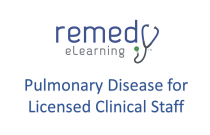Pulmonary Disease for Licensed Clinical Staff
Sheila Richmeier, MS, RN, FACMPE
1.00 Hours
This course develops the knowledge and skills needed to recognize the signs and symptoms of pulmonary disease, understand the disease process and recognize the risk factors of the disease. The content will introduce testing and medications used for diagnosing and treating pulmonary disease and will explore the actions that care....
CPAP Compliance
Medical Education Systems, Inc.
20.00 Hours
This course presents you with a variety of readings from a variety of viewpoints regarding the issues associated with patient compliance with their CPAP instructions.
Radiating Neck Pain
Medical Education Systems, Inc.
4.00 Hours
Many epidemiological studies have been carried out to assess environmental and individual risk factors for neck disorders. There is evidence from both cross sectional and longitudinal studies that work with abducted arms, forward flexion of the neck, and repetitive movements of the hands or fingers increase the risk of various n....
Preventing healthcare-associated respiratory tract infections
Dinah Gould
Respiratory tract infections have been identified as the most common healthcare-associated infection in acute hospitals. Patients most at risk are those who are critically ill, in particular patients who are mechanically ventilated. Ventilator-associated pneumonia can have serious consequences for patients, increasing morbidity....
Providing constructive feedback to students during mentoring
Kathleen Duffy
1.00 Hours
The need to provide students with regular feedback on their performance is integral to the assessment process, but not all mentors feel confident to do this. This learning module highlights the benefits of providing constructive feedback for both the mentor and the student. Five principles associated with giving constructive fee....
Care of patients with a stoma
Jennie Burch
Several diseases and operations may necessitate the formation of a stoma. Patients may be concerned about the effect of the stoma on their ability to carry out activities of daily living, as well as quality of life. Nurses who may be involved in the care of patients with a stoma should have an understanding of the reasons for st....
Parenteral nutrition: indications, risks and nursing care
Jane Fletcher
1.00 Hours
Parenteral nutrition is a recognised method of feeding patients with specific clinical conditions, most notably those with various forms of intestinal failure who cannot be fed enterally. However, it has several associated risks including sepsis, and metabolic and electrolyte imbalances. The aim of this article is to enhance nur....
Promoting mental and physical health in adults with psychosis
Hilary Jane Mairs and Tim Bradshaw
1.00 Hours
Psychosis is an umbrella term for a range of mental health problems characterised by hallucinations, delusions, and/or becoming inactive or withdrawn. This learning module explores developments in understanding psychosis and reports on progress in finding effective treatments for psychotic symptoms. While such advances offer new....
Understanding fever and the management of feverish illness in children under five years
Penny McDougall and Maureen Harrison
This learning module discusses the causes and management of fever in children. In line with guidance from the National Institute for Health and Care Excellence, it explores the importance of identifying children at risk of serious illness and those that can be managed safely at home. The module also identifies the skills and kno....
Assessment and management of patients with diabetes-related foot ulcers The management and treatment of cerebral aneurysm and aneurysmal subarachnoid haemorrhage
Emma Bowles
A cerebral aneurysm is a weak or thin spot on a blood vessel in the brain that swells and fills with blood. Rupture of a cerebral aneurysm, known as aneurysmal subarachnoid haemorrhage, is a medical emergency and is associated with increased mortality. This learning module explores the anatomy and physiology of the brain and blo....
Diagnosis, Screening and Management of Acute Stress Disorder
Department of Veterans Affairs and Department of Defense, epartment of Veterans Affairs, Ron Acierno
5.00 Hours
The course is based on the latest practice guidelines from the Veterans Administration and Department of Defense for the assessment, diagnosis and management of symptoms of ASD, Acute Stress Disorder in the immediate period after exposure to trauma. Article Author: Department of Veterans Affairs and Department of Defense, ep....
Cultural Elements in Treating Addiction in Latino Populations
Rafaela Robles EdD, CBHATTC, Wanda Rodriguez JD, LLM, CBHATTC, and Maria del Mar Garcia MSW, MPH, CB
2.00 Hours
This course is based upon a guide that was written for counselors treating clients from Latino cultures. It's purpose is to help counselors and therapists improve their skills in response to treatment challenges working with Latinos. The approach taken is to highlight key similarities and differences in cultural beliefs, attitud....
Prevention of Sexual and Intimate Partner Violence
Industry Specialist
8.00 Hours
This course is taken from a community planning guide developed by the National Center for Injury Prevention and Control and the Centers for Disease Control and prevention. It's an effective and comprehensive program based upon a multitude of approaches to prevent sexual violence and/or intimate partner violence. This guide descr....
Preventing Falls
Rein Tideiksaar
2.00 Hours
Every day, in nursing homes located throughout the United States, hundreds of residents will experience one or more falls. Are some of these residents individuals that you provide care for on a daily basis? The answer is probably yes. Prevention of falls, whether causing injury or not, is a key safety issue in nursing homes.....
Safe Patient Handling
Industry Specialists
3.00 Hours
This public domain document includes an entire curriuclum for use by nurse educators to assist in properly teaching nurses new to the field safe patient handling and movement. Feel free to download this entire document to use in your curriculum in the training of nurses new to the field. Patient-handling and movement activiti....
Optimal Living Space for People with Alzheimer's Disease
Industry Specialists
4.00 Hours
This CEU course provides: the history of Alzheimer’s care facilities; a model of residential care; case studies; and design considerations for Alzheimer’s disease relating to way-finding and orientation, safety and security, entry and egress, bathing, secure outdoor spaces, private and quiet spaces, engaged wandering, and suppor....
Cancer Research
Industry Specialists
5.00 Hours
his course was developed from the Center for Cancer Research publication which highlights several examples of how the NIH Clinical Center specializing in studying and treating rare diseases - cancers among them - have the unique capabilities to bring in and treat a critical mass of patients with cancers that might otherwise be s....
Older Adults and Mental Health
Industry Specialists
5.00 Hours
This course material focuses on mental disorders (Alzheimers, Dementia, Depression) in older adults by reviewing the normal developmental milestones of aging and then considering the diagnosis and treatment of mental health problems for this population. It reviews gains that have been made in providing services to this age g....
Breastfeeding the Infant with Medical Challenges
Linda Rogowsky RN, BSN, MS, IBCLC
This video discusses the medically challenged infant and the family particularly as relates to breastfeeding and supplementation. Included are cleft lip and palate, hypotonia, hypertonia, congenital cardiac diseases and Down Syndrome.
Aromatherapy 301: The Challenges & Successes of Aromatherapy Programs in Healthcare Facilities
Janet Tomaino, DNP, RN, AHN-BC
1.00 Hours
In every planet, there is an oil that is "essential" to that planet. These oils can be removed from the plants and used in many ways. Each essential oil has it's own unique smell and effect on a person's body. When people use an essential oil to get their bodies to respond in a certain way, it is called aromatherapy.
Opioid Addiction Treatment: Pharmacology of Medications Used
Steven Batki, M.D., et al.
3.00 Hours
The choice of medication used in medication-assisted treatment (MAT) for opioid addiction is based on safety and efficacy, patient preferences, and treatment goals. This CE course examines the pharmacology and clinical applications of the principal medications used to treat opioid addiction in opioid treatment programs (OTP).
Preventing Intimate Partner Violence Across the Lifespan
Phyllis Holditch Niolon, Ph.D., et al.
4.00 Hours
Intimate Partner Violence (IPV) is a serious preventable public health problem that affects millions of Americans and occurs across the lifespan. This CE course discusses strategies based on the best available evidence to help communities and states sharpen their focus on prevention activities with the greatest potential to pre....
Prevention and Management of Wounds in Prison Populations
Federal Bureau of Prisons Patient Education
5.00 Hours
This CEU course provides guidance on the prevention and treatment of common types of wounds, including pressure ulcers, diabetic foot ulcers, venous insufficiency ulcers, and arterial insufficiency ulcers. The focus of this course is to optimize treatment outcomes in the correctional environment.
Behavioral Health Screening in HIV Care Settings
Industry Specialist
1.00 Hours
Behavioral health screening is an important step for health care provider organizations to increase access to quality behavioral health care. This CEU course provides steps and examples that organizations can follow to build effective behavioral health screening that supports a system of integrated care.
PTSD - The Latest Research
Matthew Friedman, M.D., Ph.D., et al.
4.00 Hours
This CE course provides the latest research on posttraumatic stress disorder (PTSD) by exploring the DSM-5 changes, implementing evidence-based treatment, group versus individual therapy, child and adolescent trauma, utilizing telemental health technologies, and the role of biomarkers in the treatment and diagnosis of PTSD.











